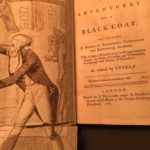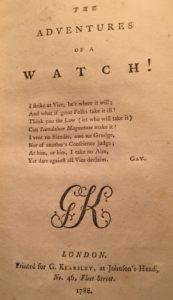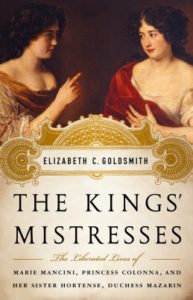By Elizabeth C. Goldsmith (Regular Contributor)
 One of the more curious types of travel fiction that circulated in the eighteenth century was the tale of the adventures of a thing. In these books, inanimate objects were the central characters and narrators. The narrator’s voice could belong to anything – one of the most popular was The Adventures of a Corkscrew, and other bestsellers were The Story of a Black Coat, The Adventures of a Rupee, The Adventures of a Watch. The voice of the narrator could also come from the vehicle by which goods and people were transported, as in The Life of a Ship, from the Launch to the Wreck, or The Adventures of a Hackney Coach.
One of the more curious types of travel fiction that circulated in the eighteenth century was the tale of the adventures of a thing. In these books, inanimate objects were the central characters and narrators. The narrator’s voice could belong to anything – one of the most popular was The Adventures of a Corkscrew, and other bestsellers were The Story of a Black Coat, The Adventures of a Rupee, The Adventures of a Watch. The voice of the narrator could also come from the vehicle by which goods and people were transported, as in The Life of a Ship, from the Launch to the Wreck, or The Adventures of a Hackney Coach.

These ‘circulation novels’ were books for adult readers, who were fascinated by the expanding consumerism and the global world of luxury goods and money. Unlike most people, objects that traveled did so freely, crossing social and territorial boundaries, moving with ease from the workshop to the street to the boudoir of a lady. Authors of circulation novels were quick to see the erotic potential in the subject. In The Adventures of a Bank-Note, the narrator is thrilled to find himself tucked between the breasts of a lady: “Oh reader, think (if thou hast any sensation) of my happy situation! Dissolv’d in pleasure, I lay gasping and panting like a great carp in a fishmonger’s basket, placed in a vale between two snowy mountains.”
By the end of the eighteenth century, though, circulation novels were increasingly written for children. Imagining the life of an inanimate object became something consigned to the magical imagination of the very young. It takes more of an effort, in the modern age, for adults to look at an item of clothing or a coin or a household appliance and muse over where those things have been, although certainly the  global travels of objects and their parts is even more vast now than it was in 1800. Victorian literature turned toward the educational value of the story of the travels of a doll or a teddy bear, and away from the playful voyeurism of traveling underclothes, jewelry, and money. Beginning with Mary Ann Kilner’s Adventures of a Pincushion, writers of circulation novels focused on the instructive utility of object adventure. The pincushion is a little philosopher, who peppers the tale with reflections on the behavior it observes and admonishes girls who behave badly.
global travels of objects and their parts is even more vast now than it was in 1800. Victorian literature turned toward the educational value of the story of the travels of a doll or a teddy bear, and away from the playful voyeurism of traveling underclothes, jewelry, and money. Beginning with Mary Ann Kilner’s Adventures of a Pincushion, writers of circulation novels focused on the instructive utility of object adventure. The pincushion is a little philosopher, who peppers the tale with reflections on the behavior it observes and admonishes girls who behave badly.
 The circulation novel or ‘it-novel’ as it is now sometimes called, survives today in children’s literature, especially of the Christmas variety, when we bask in consumer culture. From the magical bell and train in The Polar Express to the dancing toys in The Nutcracker Suite, we imagine a world where inanimate objects from around the world are alive. And Santa Claus and his reindeer are the biggest travelers of all.
The circulation novel or ‘it-novel’ as it is now sometimes called, survives today in children’s literature, especially of the Christmas variety, when we bask in consumer culture. From the magical bell and train in The Polar Express to the dancing toys in The Nutcracker Suite, we imagine a world where inanimate objects from around the world are alive. And Santa Claus and his reindeer are the biggest travelers of all.
For Further Reading: The Secret Life of Things: Animals, Objects, and It-Narratives in Eighteenth-Century England. Edited by Mark Blackwell (2007).
Elizabeth C. Goldsmith writes on the history of autobiography, women’s writing, letter correspondences, and travel narrative. Her most recent book is a biography of the sisters Hortense and Marie Mancini, The Kings’ Mistresses: The Liberated Lives of Marie Mancini, Princess Colonna and her sister Hortense, Duchess Mazarin (PublicAffairs Books, 2012). She is Professor Emerita of French Literature at Boston University.

